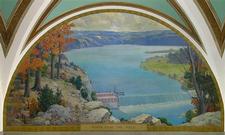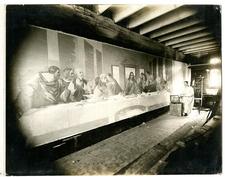Ralph Ott
_176x225.jpg) Death of Ralph C. Ott
Death of Ralph C. Ott
Springfield Leader, October 1, 1931, page 2
"Ralph Chesley Ott, 58, nationally eminent artist, died suddenly of a heart attack at the Ott home, 940 South Weller Avenue, Wednesday afternoon. Funeral services will be Friday afternoon at 3:30 o'clock in the Alma Lohmeyer Chapel, with the Reverend F. W. Sherman, rector of Christ Episcopal Church, officiating. Burial will be in Maple Park.
"Mr. Ott had spent all summer in Springfield with his sister, Miss Cora Ott, and his two daughters, Misses Arcea and Mary Jane Ott. In April, he suffered a severe attack of influenza, which left his heart weakened, and during his long convalescence here he lived in an enforced quiet for the first several weeks seeing virtually no one.
"Lately, however, he had seemed much better and had been eager to resume his work as early as possible. A few weeks ago, he thought he was well enough to return to St. Louis to work on some waiting commissions, but his health did not permit the trip.
"Mr. Ott was born in Springfield, the son of Eli D. Ott and Mary Cannefax Ott, daughter of Chesley Cannefax, Greene County's first elected County Clerk and Probate Judge.
"As a schoolboy, Ralph Ott showed the artistic taste and talent that his career so successfully developed, and even in the grades he was selected to decorate the blackboards with pictures, because of his natural skill in drawing. While in High School here he acquired the habit of always carrying a sketchbook with him, and was incessantly working on a seemingly endless number of sketches. Some of these early school-days sketches have been preserved, and most vividly reveal his innate ability.
"Finishing high school, he went to Washington University art school, paying his first-year expenses by selling his work. From the first he seems to have found a market, and never at any time was compelled to turn to the commercial phases of art. His work was so outstanding that after the first year, he finished at the university with a succession of scholarships. Even as a youth, he exhibited at the St. Louis expositions, and won honors from the first.
"After his years at the university, he went to Paris, and there also won immediate recognition, so that his work was exhibited 'on the line' the first year. Later he continued his studies in Florence and Rome; and having from the first been impressed and influenced most by Whistler and Velasquez, he spent eight months in Madrid, to make a more profound study of Velasquez's work.
"Though it is little known, he also spent some time in Egypt, where he was commissioned to get material preparatory to the erection of the Egyptian building in St. Louis. He did the task so excellently that every detail, not only of architecture and furnishing, but of the smallest accessories, was meticulously accurate.
"For a short time Mr. Ott worked in New York, but did not like to live there, so although he continued to exhibit there annually, he lived the greater part of the time for many years in St. Louis or Philadelphia during the winter, and at Provincetown or Glouchester during the summer. It was his invariable habit, however, to return to Springfield at least twice a year.
"Possibly the most widely known of Mr. Ott's work is his series of portraits of Missouri Governors for the state capitol, and governors' wives for the governor's mansion. His work in the capitol also includes the mural, 'Power from the Hills.' Only illness prevented his competing for the commission to do a Wilson Creek Battlefield canvas for the capitol – which would have been especially appropriate because his mother was a resident of that neighborhood.
"Mr. Ott was especially famed for his portraits. In his early days he had done one of Dr. Horatio Nelson Spencer of St. Louis, which was so successful that a series of commissions from outstanding St. Louis medical men followed. Recently, also, he had done a series of portraits of grand masters of Masonry.
"Not so widely known here as some of his other portraits but considered very important and fine, are three in the Chicago Theological seminary, one in the George Commons of Dr. Joseph H. George, who was president of the seminary and also of Drury College and whose widow now resides here in Springfield; one in the Lawson Tower of Victor F. Lawson, Chicago publisher, who left one-third of his estate, upwards of $3,000,000, to the seminary; and one in Davis Tower of Dr. Ozora Stearns Davis, who for many year was president of the school.
 "One of his murals, 'The Lord's Supper,' is in St. Paul Church here; and the Springfield Museum of Art has recently purchased a painting of rare, rich and subtle beauty, known as 'Morning'. Almost the last painting he finished was a portrait of the St. Louis artist, Frank Nuderscher. Mr. Ott's work is distinguished by drawing that is splendid and true, and excellent craftsmanship, colors more beautifully toned, and an atmosphere of poetic charm.
"One of his murals, 'The Lord's Supper,' is in St. Paul Church here; and the Springfield Museum of Art has recently purchased a painting of rare, rich and subtle beauty, known as 'Morning'. Almost the last painting he finished was a portrait of the St. Louis artist, Frank Nuderscher. Mr. Ott's work is distinguished by drawing that is splendid and true, and excellent craftsmanship, colors more beautifully toned, and an atmosphere of poetic charm.
"He was a man of wide range of interests. In art, he had experimented with sculpture and pottery, besides excelling in his chosen field of portraiture and murals. He was a sensitive musician and skillful violinist; and an almost inveterate reader. His literary tastes lay among standard authors, and he avoided contemporary 'best sellers.' Books he loved, he not only read, but frequently reread, and his intimate knowledge of Shakespeare was amazing. Deprived of activity this summer, he read almost constantly, and the joy of it greatly mitigated his enforced idleness.
"Mr. Ott was alone at the time of his death. He was discovered by R. R. Whittaker, foreman of the Lee Savage Paint Company, which had been doing some painting at the home. A collie pup, a constant companion, was curled up beside his master's fallen body."
The color image of Power From the Hills, is used with permission of the Missouri State Archives. The black and white images are from the Local History Department archives.
Find this article at http://thelibrary.org/blogs/article.cfm?aid=4478&lid=0